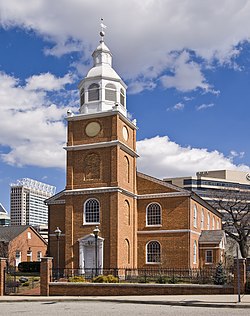Otterbein Church (Baltimore, Maryland)
|
Otterbein Church
|
|

Old Otterbein Church in 2012
|
|
| Location | 112 West Conway Street at South Sharp Street, Baltimore |
|---|---|
| Coordinates | 39°17′4″N 76°37′2″W / 39.28444°N 76.61722°WCoordinates: 39°17′4″N 76°37′2″W / 39.28444°N 76.61722°W |
| Area | 0.6 acres (0.24 ha) |
| Built | 1785 |
| Architect | Jacob Small, Sr. |
| Architectural style | Georgian architecture |
| NRHP Reference # | 69000324 |
| Added to NRHP | October 28, 1969 |
Otterbein Church, now known as Old Otterbein United Methodist Church, is a historic United Brethren church located in Baltimore, Maryland, United States. The first "German Reformed" church was built to serve the German Reformed and some Evangelical Lutheran immigrants, and later entered the Brethren strain of German Reformed Protestantism in the later Church of the United Brethren in Christ. It is a two-story brick Georgian structure with a peaked roof, built 1785-1786, and features a square bell tower and an octagonal white "cupola-on-cupola", with much of the original wavy, hand-blown glass window panes still remaining. It had a major remodeling occurring in 1839, and some additional cleaning and restoration of its exterior brick walls and wall-fence surrounding the parish. The tower's bells date to 1789, and are still in use. That same year, the first Conference of United Brethren preachers was held and resulted in the official organization of the Church of the United Brethren in Christ, with Pastor Philip William Otterbein, (1726-1813) as a bishop (five years after he participated in the "laying on" of hands on famous evangelist and missionary Francis Asbury, (1745-1816), ordained as the first bishop of the new Methodist Episcopal Church. He was later buried in the adjacent churchyard, surrounding the building.
Old Otterbein Church is located just east of the landmark Camden Street Station and three blocks west of the Inner Harbor. For decades it was surrounded for many blocks in every direction by very densely packed neighborhoods of rowhouses, businesses and factories/manufacturies. In the last two decades, most of these former structures have been razed. Much of this area is now occupied by Oriole Park at Camden Yards baseball stadium (built in 1992), the Baltimore Convention Center (built 1979, with a large 2002 addition), and several large glass-towered hotels of national chains, to the east, west, and north.
...
Wikipedia



